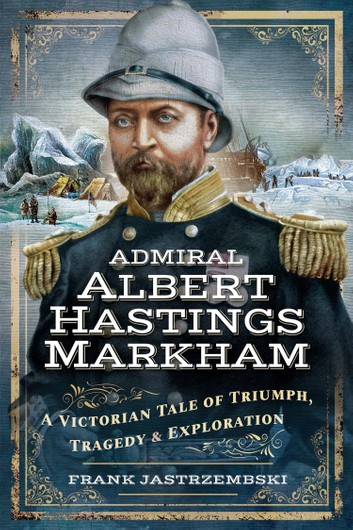
Admiral Albert Hastings Markham; A Victorian Tale of Triumph, Tragedy and Exploration. By Frank Jastrzembski. Pen and Sword Books, Barnsley, 2019.
Reviewed by Tim Coyle
This biography of Albert Markham has all the derring-do associated with a Royal Navy officer of the Victorian era. Having defeated the French maritime strategic threat at Trafalgar in 1805, the Royal Navy was seized with a peace dividend that saw ships decommissioned, sailors discharged, and officers retired or sent to the limbo of half pay. However, the British Empire was burgeoning and RN ships were sent to its far-flung corners to institute and maintain a ‘Pax Britannica’ we would today regard as maritime constabulary operations. Officers seeking fame and promotion had ample opportunities to enforce imperial law, engage in ‘gunboat diplomacy’ and, for the obsessive, there was the lure of polar exploration.
One such officer was Albert Markham, a voracious reader, writer, accomplished naturalist and fearless explorer. His campaigns ranged over the South China Sea where he battled piracy and fought in the Second Opium War, countering the ‘blackbirding’ of South Pacific Islanders – virtual slavery – as the captain of a ship on the Australia Station, suffering enormous privations in attempts to reach the North Pole – he got to within 400 miles – travelled in the American West in the manner of the best Western legends, observed war in South America and explored in the fierce Canadian north.
However, feted and promoted as a result of his adventures, Markham is perhaps best known for the disaster visited on the RN Mediterranean Fleet on 22 June 1893 when, as second-in-command of the Mediterranean Fleet his flagship, HMS Camperdown, collided with and sank the commander-in-chief, Admiral George Tryon’s flagship, HMS Victoria. The manoeuvre had been ordered by Tryon and the sequence of events which led to this disaster starkly demonstrate the rigid adherence to orders typical of the time. Although Markham was cleared by the board of enquiry, he languished on half pay for seven years and was only recalled as Commander-in-Chief, The Nore by intervention of the Prince of Wales.
The author, Frank Jastrzembski, recounts Markham’s life with a genuine affection for this Victorian hero. Markham’s writings were extensive on which the author has drawn, together with a formidable bibliography, to present Markham as a resourceful and driven adventurer. As a commander he was accused of being a martinet; however, his regard for subordinates was genuine and this is particularly evident in the recounting of his Arctic expeditions.
The book is well illustrated and includes maps of areas in which Markham served. One minor observation is that Jastrzemski, in common with many American writers, refers to the ‘English’ when he means British; however, this does not detract from the overall high standard of the book’s tribute to Markham.
Perhaps the most absorbing part of the book is the last chapter, The Fiend of Misfortune. This covers the notorious Mediterranean Fleet Camperdown-Victoria collision and is particularly dramatic and poignant. While undoubtedly well-known to those drawn to RN history, Jastrzemski retells the path to disaster in the doubts of the staff when details of Tryon’s manoeuvre were promulgated. Markham, famous explorer and rear admiral second-in-command of Britain’s premier fleet, in a split second reacted with trepidation and doubt to his commander-in-chief’s ill designed manoeuvre order. Who in the Victorian era RN could possibly refuse the direct orders of a commander-in-chief renowned for his dashing tactical innovation and towering reputation? Put yourself in Markham’s position in 1893 on the bridge of the flagship of the second division of the Mediterranean Fleet. He led six battleships of the second division when ordered to turn inwards towards Tryon’ six battleship first division; the distance apart in cruising order was 1200 yards. However, to turn safely inward and reverse course by 180 degrees required 1600 yards – what would you have done?
With Tryon’s flagship’s signal hoisted for the manoeuvre only Markham’s ship did not acknowledge the hoist. When Markham realised the two columns were too close to safely conduct the manoeuvre, he told his flag lieutenant ‘it is impossible, as it is an impractical manoeuvre’. Markham kept the Camperdown’s signal ‘at the dip’ to indicate that the Victoria’s order had not been understood. Markham’s flag captain, equally concerned, asked Markham what to do; he replied ‘It is alright. Don’t do anything’. Markham then directed a semaphore signal to be sent to Victoria: ‘Am I to understand that it is your wish for the columns to turn as indicated by the signal now flying?’
Before the Markham’s semaphore was sent, Tryon’s signalled ‘what are you waiting for?’ Markham’s instantly rationalised that Tryon intended Markham’s column to wheel around outside of Tryon’s. False assumption and resultant disaster. Markham instantaneously bowed to Tryon’s reputed tactical brilliance which failed on this occasion.
This book is a great read, exemplifying that genre of peculiarly fascinating characters, the Victorian era Royal Navy officer in the person of Admiral Albert Hastings Markham. It is indeed ‘A Victorian Tale of Triumph, Tragedy and Exploration’: highly recommended.



